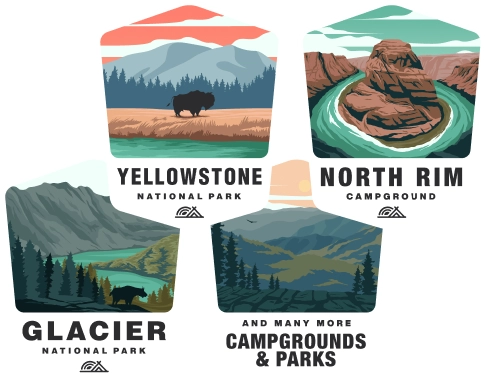Camping at Sequoia National Forest
Overview of Sequoia National Forest
Sequoia National Forest, located in the southern Sierra Nevada mountains of California, is famous for its giant sequoia trees, including the world's largest tree, the General Sherman tree. It encompasses over 1.1 million acres of mountainous land and offers a variety of recreational activities including camping, hiking, mountain biking, horseback riding, and rock climbing. The forest is managed by the U.S. Forest Service.
Camping Options
Developed Campgrounds
- Reservation Campgrounds: Some campgrounds can be reserved in advance through the national reservation system, Recreation.gov.
- First-Come, First-Served Campgrounds: Others operate on a first-come, first-served basis, so early arrival is advised during peak season.
Dispersed Camping
- Dispersed camping, or backcountry camping, is permitted in many areas of the forest outside of designated campgrounds, but campers must follow Leave No Trace principles and regulations.
Group Campgrounds
- Larger groups can book group sites, which offer more space and amenities for bigger parties.
Campground Amenities and Facilities
Facilities vary depending on the campground and may include picnic tables, fire rings, flush toilets, vault toilets, and potable water. Luxuries such as showers and RV hookups are less common and may only be available at some locations.
Campfire Permits
- Permit Requirements: All campers planning to have a campfire or use a stove/fire outside of developed campgrounds must obtain a campfire permit. Permits are available at any Forest Service, BLM, or CAL FIRE office or online through the appropriate agencies.
- Fire Regulations: Check for fire restrictions before your trip, as they can change due to weather conditions and wildfire risks.
Weather and Best Time to Visit
- Seasonal Considerations: Weather in the Sequoia National Forest can vary greatly with elevation. The summer months (June through August) are typically warm and dry, making it an ideal time for camping. Winter brings snow, especially at higher elevations, and many campgrounds will be closed.
- Off-Peak Times: The spring and fall can be great times to visit, with fewer crowds and mild weather, but some facilities may be limited.
Wildlife Precautions
- Bears: The forest is home to black bears. Proper food storage is mandatory, and bear-proof containers are recommended or required in some areas.
- Other Wildlife Precautions: Campers should also be aware of other wildlife and take precautions to avoid attracting animals to their campsites.
Hiking and Trails
- Trail Options: There are numerous trails ranging from easy to strenuous. Popular hikes include those in the Giant Sequoia National Monument within the forest, where hikers can marvel at the immense size of the sequoia trees.
- Permits for Wilderness Areas: Some wilderness areas within the forest may require a wilderness permit for overnight hikes.
Conservation and Regulations
- Leave No Trace: Campers are urged to follow Leave No Trace principles to minimize their impact on the natural environment.
- Fishing and Hunting: Licenses are required for fishing and hunting, with specific regulations in place for each activity.
Access and Transportation
- Roads and Access Points: Some areas may be remote and only accessible by unpaved roads, suitable for high-clearance or 4WD vehicles.
- Accessibility: Accessibility for those with disabilities may be limited in certain areas, so it's advisable to check in advance for specific needs.
- Public Transportation: Public transportation options are limited, so visitors typically need a private vehicle to access camping areas.
Reservations and Fees
- Booking Campgrounds: Campgrounds can be reserved through Recreation.gov, and fees vary depending on the site and amenities.
- Passes: Some areas may require an Adventure Pass for parking and use. Passes can be purchased in advance or at local vendors.
Local Attractions and Activities
Beyond the sequoias, the forest offers a plethora of other attractions like rock climbing at the Needles, exploring the Kern River for rafting and fishing, and checking out the Trail of 100 Giants.
Safety Precautions
- Emergency Preparedness: Have a plan for emergencies, and understand that cell service may be unreliable. Bring first aid supplies and inform someone about your itinerary and expected return time.
- Mountain Safety: Be prepared for mountainous terrain and rapidly changing weather conditions. Altitude sickness can be a concern at higher elevations, so acclimate appropriately.
Before heading off on your adventure, be sure to check the latest information and updates from the U.S. Forest Service or the Sequoia National Forest's official website. It is important to plan ahead and ensure that your camping experience is both enjoyable and in compliance with all the regulations and guidelines put in place to protect this incredible natural resource.
